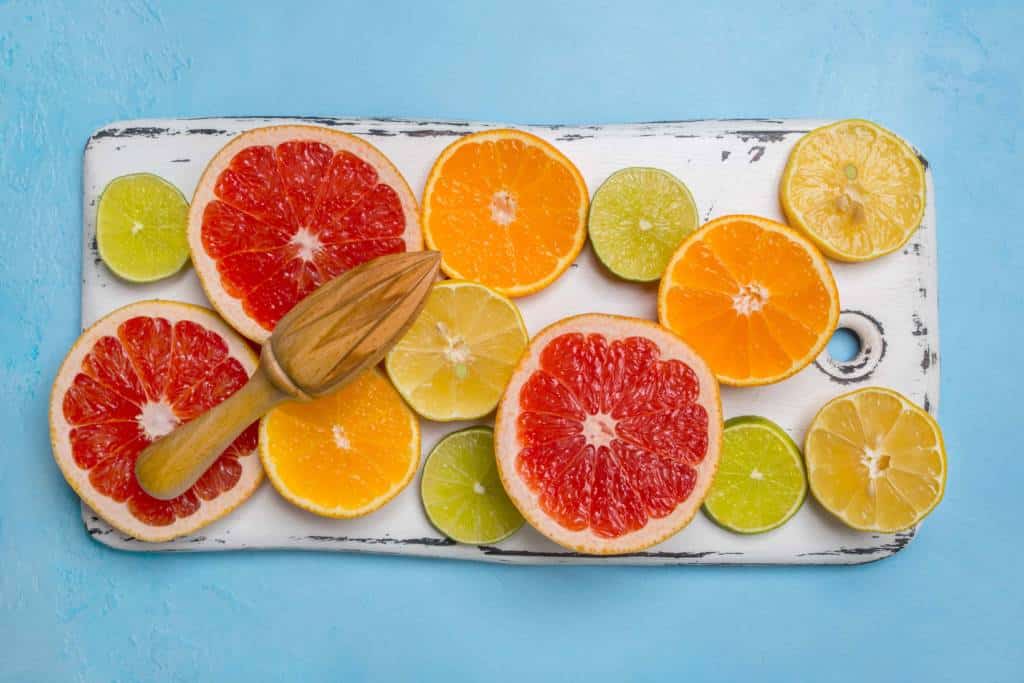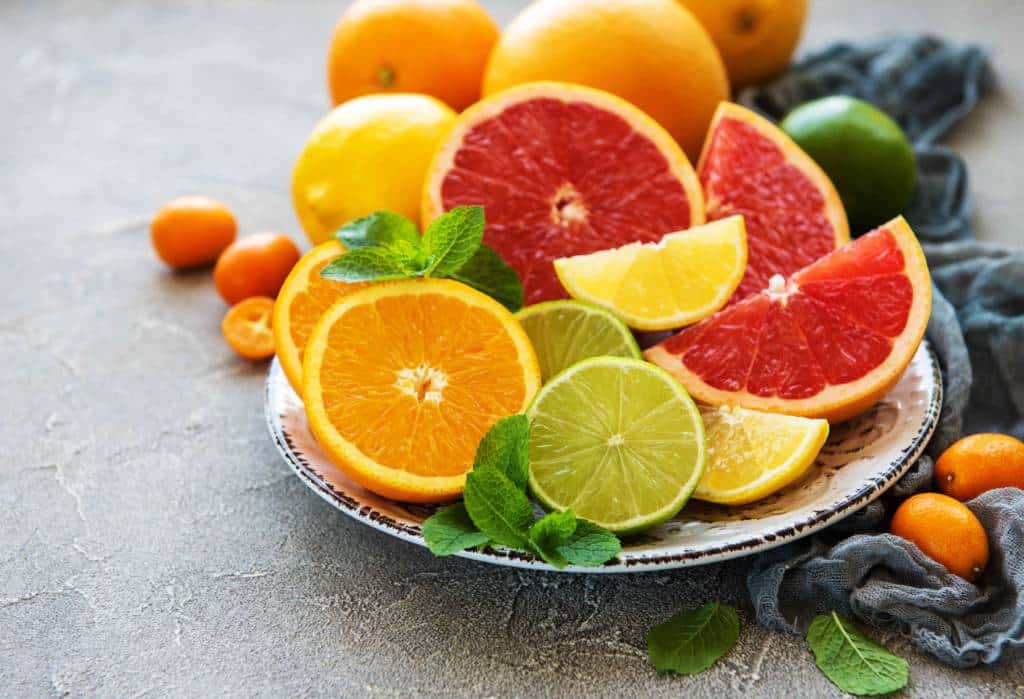6 Reasons You Should Add Citrus Fruits to Your Diet

Mehak Shah
October 12, 2022

Mehak Shah
October 12, 2022
The citrus family of fruits is a genus of plants and trees in the flower family of Rutaceae. Citrus fruits are the largest traded horticultural commodity in the world.
Citrus fruits are very potent healthy food sources, portable, and are delicious. In addition, they provide essential vitamins like C and B6, carbohydrates, fibres, potassium, calcium, and much more.
A common myth exists that these fruits are simply rich in Vitamin C, but citrus fruits have much more to offer than just that. They present countless health benefits in major and minor ways. They are also a great way to incorporate healthy eating into your diet.
Originating far away in South Asia and Australia, citrus fruits are now grown all over. So much so that the annual production of just oranges is about 70 million tonnes! We all see orange citrus fruits during the winter, especially in the months when most of us have a cold or the flu.
Some of the most famous members of this family are oranges, tangerines, pomelos, grapefruits, lemons, and limes. Large quantities of these fruits are grown around the globe. Not only for being fruity and juicy but also for their matchless health value. They are high in flavonoids that inhibit cancer growth. They also contain phytochemicals and various vitamins.
So if you’re looking to move on from the myths behind citrus fruits and get a quick and easy way to become healthier, this article will give you ten reasons to make that change.
Different kinds of citrus fruits find their origins in a myriad of regions. So there is no particular location. Since the seeds of these fruits don’t have restricted growth conditions, they can grow all over. Therefore, they lack an established history of cultivation and commercial sale. One can trace their origins in particular countries, but their benefits caught wind. Before anyone knew it, they became common in marketplaces around the globe.

The citrus family is extensive, but studies usually divide them into six subgroups to comprehend data better. Those six subgroups are :
With roots in the Indian subcontinent, the orange is the king of citrus fruits and has seen commercial agriculture for centuries. Oranges are excellent sources of vitamin C and have fibre and beta-cryptoxanthin. They eliminate waste from the body and aids blood circulation.
Following are the nutritional values of a 100g serving of oranges:
Originally cultivated in Iran and Egypt, lemons find their uses in all households. A staple to make a dish that is a little bit zestier, they have always held their charm as a tasty but healthy addition to food. Like oranges, lemons are rich in vitamin C. What’s unique about them is that they contain antioxidants and have a long shelf-life!
These are the nutritional values of a 100g serving of Lemons :
They’re the fundamental brother of lemons. Limes have suffered being confused for being others many times. Tracing their birth in Southeast Asia, Limes contain more sugar and citric acid than lemons and have been used as a dressing for food long since. They reduce inflammation and speed up recovery.
These are the nutritional values of a 100g serving of Lemons :
Originated in the early 17th century somewhere near Barbados, grapefruits are arguably among the more beautiful and healthiest citrus fruits to eat. Grapefruits are unique because they have special flavonoids which help prevent diabetes and protect your liver.
These are the nutritional values of a 100g serving of Grapefruits :
Citrus fruits are good for you, taste great, and are easy to carry and consume. We just listed the countless health benefits it has, both mental and physical.
Many people don’t believe it, but studies suggest citrus fruits help alleviate mental health issues in more than one way. For example, most citrus fruits contain a crystalline element called Apigenin. Apigenin has antidepressant qualities. Some flavonoids present in citrus fruits even exhibit antiallergic and anti-anxiety properties.
Moreover, citrus polyphenols can prevent and reverse neuro-degeneration by protecting neural cells from inflammation, crucial in mental disorders. Research suggests Citrus bioactive compounds improve general cognition.
So citrus fruits help people suffering from signs of early-onset depression or anxiety. Moreover, citrus fruits boost their mental and physical health simultaneously.
Citrus fruits are excellent for boosting metabolism. They do so in many different ways through different chemicals and elements. For example, they contain Vitamins B3, B6, and B9, which balance the body fluids, keep haemoglobin and check and strengthen the metabolic process in the body.
But that’s not it. Essential minerals like calcium, manganese, and zinc are also present in citrus fruits. They aid metabolism and strengthen teeth and bones. Furthermore, these minerals also boost blood circulation in the body.
Citrus fruits contain essential acids like ascorbic acid, thiamine, and vitamins like B, B2, and B3. They help relax the blood vessels and aid oxidation. As a result, oxygen-rich blood passes throughout the body. Essentially, this means all your organs will respond well to the blood they receive. Thus, they are less likely to decay from either a lack of blood or receiving carbon-rich blood. Moreover, minerals like phosphorus and selenium present in citrus fruits aid DNA production and energy distribution.
In congruence with the gains mentioned above to Mental Health, these elements help calm the nerves. A study revealed they reduce reflex time and increase motor functions in humans. So the major transport systems of your body, the ones instrumental in keeping you alive, are even more successful when supplied with Citrus Fruits!
It is common knowledge among experts that citrus fruits expedite the healing process after a good workout, resulting in stronger muscles. But many people don’t know that rigorous training and exercise isn’t mandatory for extracting the best out of what these fruits have to provide for your muscles.
They help in forming connective tissues, repairing internal damage to organs, and the vitamins help the body respond well to all kinds of injuries. For example, calcium and Sodium enhance the structure and rigidity of the body’s skeletal system. Magnesium helps muscle contraction and relaxation during body movement. The zinc also helps relax sore muscles.
Ironically enough, getting, peeling, and eating citrus fruits is an excellent pass of time. In addition, it helps balance out any other cravings you might have had the night before. Your hand-eye coordination improves too. When the body receives nutrients and food in a timely and balanced manner, it responds well to the respective food. If you want your body to help you, you’ll have to help your body first!
At the beginning of the article, we talked about citrus fruits containing flavonoids and phytochemicals. After an intrinsic and careful study of citrus fruits and their antioxidant properties, there were no doubts about their efficacy. However, there are several other benefits that these citrus fruits have to offer.
Copper and selenium found in citrus fruits are essential traces for physical wellbeing. Independent studies have shown citrus fruits to reduce high blood pressure and lower bad cholesterol (LDL). Citrus Fruits, like most fruits, have very high water content. Consumption naturally delivers water to the body, which also helps in staying hydrated.
So overall, we learn that citrus fruits have many benefits for your body, be it physical or mental. Therefore, it virtually eliminates any myth about eating citrus fruits. It also gives you more reasons to try out what you’ve been missing out on for so long!
We understand eating the same fruits again and again daily just because it’s healthy can be a little boring. So here are a few recipes to spice up that Citrus-y experience of yours!

Servings: 4
Preparation Time: 20 mins
Servings: 2
Cooking Time: 20 mins
Servings: 8
Cooking Time- 20 mins
As with all things, one should consume citrus fruits in moderation. However, even the best things have downsides, and citrus fruits are no exceptions. Eating more than the recommended amount of citrus fruits and juices increases the chance of developing cavities. This oral issue is because of the acid in citrus fruits. It acts as an eroding agent and erodes the enamel of your teeth.
Too much citric acid has serious side effects. These include numbness, swelling or rapid weight gain, cramps, faster heart rate, mood swings, stomach pain, or seizure, but these are only the most severe cases.
Either way, everything you intake should be balanced and healthy.
If you consume up to 5 servings of citrus fruits a day, the total intake of vitamin C would be around 200mg. However, this isn’t lethal or dangerous, but it’s better not to exceed this limit and stay under it. More than five servings also result in too much fibre intake, which may cause issues in excretion. Therefore, take 2-3 servings daily at most.
The daily limit for juice intake is around 7-8 ounces (~240mL). Juices made from fresh citrus fruits usually contain about 0.2 g/oz of citric acid. Excess of citric acid can have serious problems.
Research suggests the maximum daily dose to be around 10mL diluted. Anything more will show side effects.
Now that we’re aware of how much value citrus fruits can provide for your body and mind, making the switch will never be more effortless. It’s time to leave behind those age-old myths and get some citrus in your life!
If you still feel confused or need answers to some questions, here are our most frequently asked questions about citrus fruits.
A. There are many fruits in the citrus family. However, they are divided into subgroups. These subgroups are sweet oranges, bitter oranges, lemons, limes, grapefruits, and other varieties, including kumquats, yuzu, and citron.
A. No, Apple is not a citrus fruit. Other fruits that do not belong to the citrus family include pears, watermelon, and raspberries.
A. Even though they seem to have a lot in common, like vitamin C, pineapple is not a citrus fruit. Therefore, they are not related to one another.
A. Papaya does contain small amounts of citric acid, but it does not belong to the genus of citrus fruits. It is a low-acid fruit with 0.1% of citric acid.
A. No, strawberries are not citrus fruits. In comparison to citrus fruits, they grow in northern latitudes and do not have a thick, fleshy rind.
A. A lot! They increase metabolism, help muscles, bones, digestion, brain, heart, and physical and mental wellbeing.
A. There is no healthiest citrus fruit per se, but research suggests Grapefruits are one of the healthier ones. It is because they are rich in vitamin C, potassium, and fibre.
A. No! As long as you take them in moderation. Add citrus fruits to your meals and have a balanced diet. Consuming citrus fruits daily is very good for you and has countless health benefits!
A. Yes, Indeed! Citrus fruit extracts are advertised in skincare products repeatedly because of their antioxidant properties. In addition, they clear out your skin and give it a natural glow!
A. Depending on a person’s desired intake, using such fruits as a source of Vitamin C requires only one or two servings per day. Therefore, this meets the daily recommended allowance.
A. Citrus fruits, such as lemons, limes, oranges, and grapefruit, are acidic. As a result, they can irritate the stomach lining, causing digestive problems, and in some cases cause internal damage. But for the most part, citrus fruits don’t do any irreparable damage.

